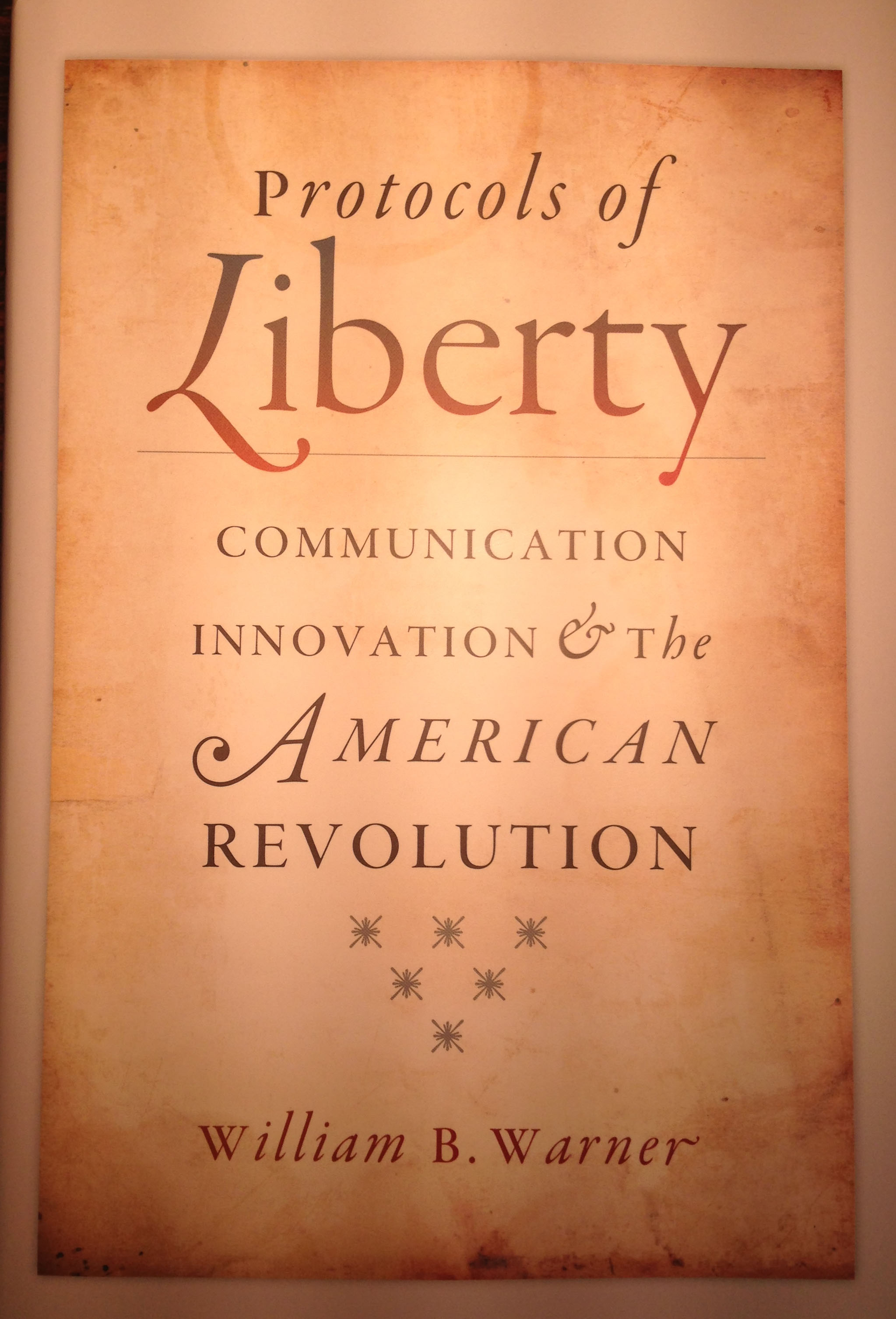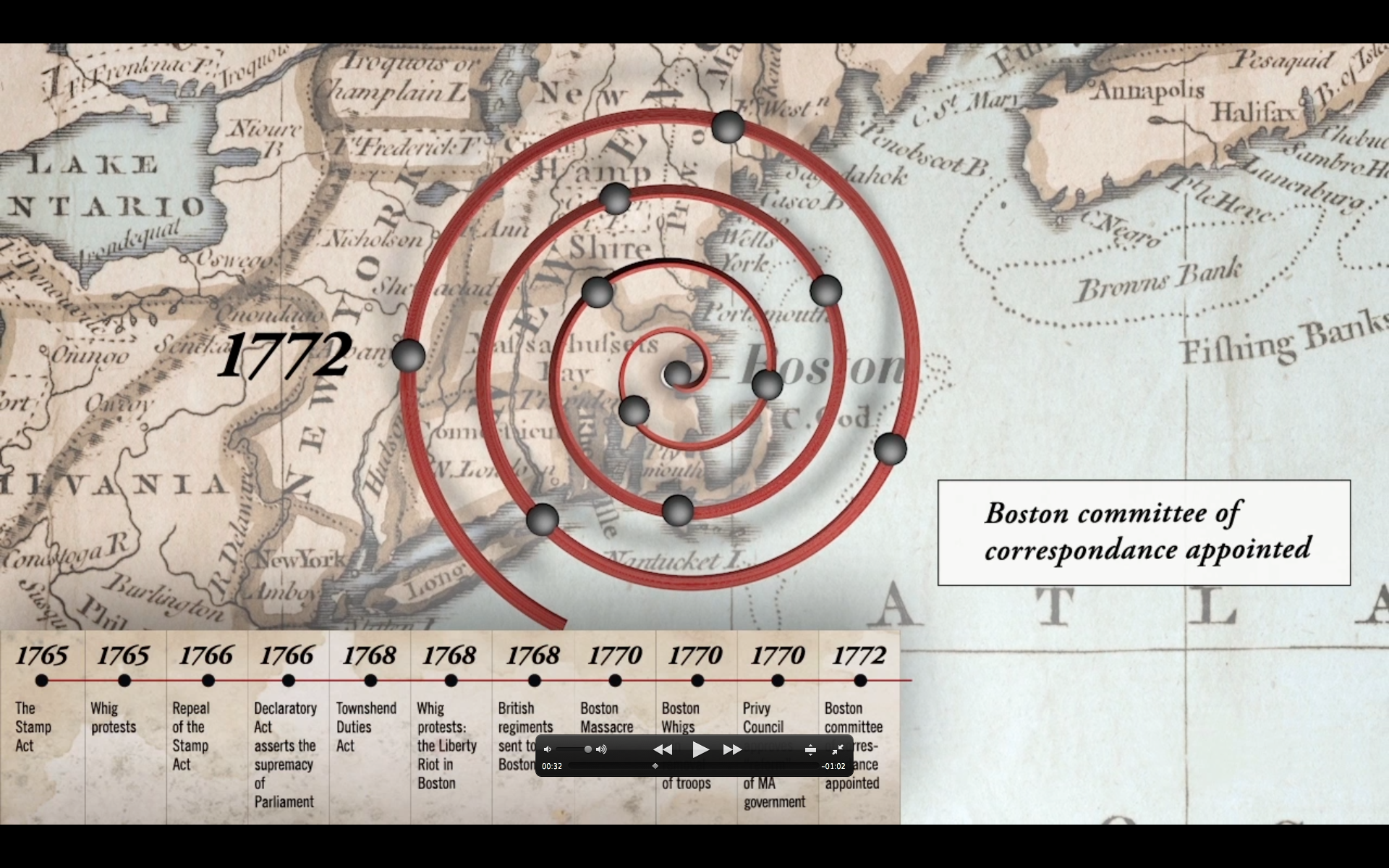PROTOCOLS OF LIBERTY is winner of the 2013-2014 Louis Gottschalk Prize Competition
The Prize Committee Commendation
This is a WEBFRAME, but what is that?
A webframe is a setting or framework provided for a published book or article. This webframe has been created for a particular object and occasion: the book, Protocols of Liberty, published by the University of Chicago in the fall of 2013. In the months before publication, I have worked with others to provide a setting that supplements and extends the book-length monograph without in any way replacing it. Thus I have avoided duplicating the text of the book on this website. The pages, images, diagrams, graphs, animations, audio and text of this webframe can be understood in isolation, however, each will gain coherence in relation with the carefully composed linear argument of Protocols of Liberty. [CLICK upon cover image to go to the University of Chicago Press site page devoted to this book.]

Thus I envision this webframe as having its greatest pertinence and utility for those who are reading, or have read the book, Protocols of Liberty: Communication Innovation and the American Revolution. The brief abstracts of the chapters and the collection of supporting illustrations are arranged in the order of the printed monograph. (See "Table of Contents" at RIGHT). In this regard the webframe is ordered like the book it frames. However, in developing this website, I gained a fresh perspective upon the compositional decisions embedded in the book. In order to compose a logical linear narrative with a coherent argument of readable length, I bypassed or downplayed some of the meaningful connections uncovered by the project. Of course, any historian who enters an archive and writes a book must develop interpretations that abstract and simplify that archive. However, the horizontal, distributed structure of the Web has enabled me to develop a webframe that offers an associative and exploratory principle of organization most common in networks. The clusters of LINKS (SEE on the RIGHT), each developed around a distinct topic, serve as vectors that enable a user to negotiate the issues and objects of this topic in a fashion that is quite different than the experience provided by the monograph. I'd like to think that this second mode of presentation and reception, where each page serves as a quasi-independent module, restores to this project some of the anarchic character of the archive. As an heir to the rich affordances of the Internet, this web publication can incorporate audio and video, live links and animations, mapping and search. (My most ambitious attempt, Vortex of Revolution: An Animation, is mounted below on this page.) In some sense we authors of the post digital media-scape find ourselves in the happy situation of those Victorians who enhanced printed books with graphic illustration, maps, photographs and facsimiles of all kinds. Although I, like every scholarly author, find it difficult not to see the big world through the optics provided by my little project, I have sought to exercise restraint and economy in designing this webframe. I hope the visitor to this site will use it to deepen their engagement with the rich eighteenth century archive of text and image and sound out of which both it and the monograph it frames emerged. If you have any corrections or critical commentary for the author of this site, you can send them to me, William Warner, at warner@english.ucsb.edu.
|
OVERVIEW:
Protocols of Liberty offers an account of how, in the midst of a chronic political crisis, American Whigs seized the political initiative through a set of interrelated innovations in communication. To understand the power of these innovations, this book zooms into moments of political crisis in British America where events could have gone either way: the day after the Boston Massacre; the late December days of 1773 that culminated in the destruction of the tea in Boston harbour; late May 1774 when the Virginia committee of correspondence responded to Parliament’s punitive bill closing Boston harbour. In the final years before revolution, American Whigs gained leverage from their earlier invention of the standing committee of correspondence and the popular declaration, and their deployment of both to develop an intercolonial network of America Whigs. This Whig network could only emerge because of the character of two media institutions that had developed over the previous century: the postal system and the weekly newspaper. By being open, public, and free (of government control), the newspapers and the postal system served as robust supports for political communication. Throughout the political crisis what was done depended on how political sentiments were communicated. At the heart of revolutionary communication were certain generally observed protocols—of legal procedure, corporate action, public access, general address, and virtuous initiative—which this book traces through the full arc of the political crisis: from the Boston town meeting’s appointment of the committee that composed a public statement of their rights and grievances to the Continental Congress’ drafting and publication of the Declaration of 1776. |
TABLE OF CONTENTS OF THE BOOK
Introduction
|
Communication and the American Crisis |
Chapter 1
|
The Invention of the Boston Committee of Correspondence and the Popular Declaration |
Chapter 2
|
The Protocols of the Declarations and the Eclipse of Royal Power in Massachusetts in 1773 |
Chapter 3
|
The Post and Newspaper in British America: A Communication System in Crisis |
Chapter 4
|
The Whig Network Scales Up: Inflecting the Crisis from Williamsburg |
Chapter 5
|
“A Chain of Freedom Has Been Formed” : The First Continental Congress Develops into the Hub of an Intercolonial Network
|
Chapter 6
|
The Panorama of the Declaration
|
| Conclusion |
The American Revolution as a Gift |
|
Why represent a revolution as a vortex?
There is a genuine mystery about the migration of power from British Royal officials to the Whig leadership of the 13 colonies of North America between 1772 and 1775. Such a shift is integral to a “revolution,” whereby the legitimacy and effective authority of the British Empire, as it was embodied in oaths of loyalty and toasts to the King's health and given form by instructions, dispatches, appointments of Administration in Whitehall, lost its hold on most colonists. At the same time, new centers of power and legitimacy emerged. How did this happen? Protocols of Liberty offers an account of this throughgoing political metamorphosis. But how might we visualize this change? The following animation takes the traditional form for representing a sequence of historical events, the timeline, and sets it in motion. It assumes new forms, first as a vortex, which represents the engulfing vacuum into which British power disappears; then, as a pyramid, which symbolizes the emergent power of the Congress; and, finally, as a flat spiral, which represents the network of colonies that unite to wage war.
Designer's Note by Yoann Resmond
The Concept: Representing a timeline in the form of a vortex was a fascinating idea, but it also turned out to be a complex one. Circles create revolutions when they are in motion, so it made sense for this Revolution timeline to be of circular form. The true level of complexity came from the notion of reversal: at first a timeline is spiraling down, however eventually a shift occurs: the Vortex becomes a pyramid. This change reflects how history can be viewed differently depending on perspective, or which side of it we are on.
|

Achieving the effect: It was clear that this circular timeline had to be moving in 3 dimensions. I've had some experience with 3D animation in the past, but hadn't dabbled in the technique in many years, so my first challenge was to animate in 3D with a new tool: Cinema 4D. Since I learned while creating this animation, it was no easy task. The tricky part was matching the 3D animation to the storyboard. The look and feel of 2D animation achieved with After Effects came through more naturally. The most challenging part of this animation was to control the 3D spiral in its reversal. This took more hours of trial and error than I can account for, but in the end, it worked.
Connecting all the parts: The 1st key connection was for the spiral to relate to the geographic city of origin: Boston, then to its second location: Philadelphia. The 2nd necessary relation was for the timeline date dots on the spiral to synchronize with the more traditional bottom linear Timeline in 2D, allowing the viewer to track the temporal progression. The 3rd and final key connection was to fuse the 3D and 2D animation and make the animation work as a whole.
Soundtrack: Beethoven, 3rd Piano Concerto, 1st movement
|
|
Acknowledgments: This site is part of an academic publishing initiative within UC Santa Barbara's Early Modern Center, a research center within the English Department. We are calling it the EMC Imprint. My deepest debt goes to Christopher Foley, who has been the architect, designer and initial editor for this website. Also thanks to Brian Reynolds for vital tech support. Feel free to send corrections or comments to me at warner@english.ucsb.edu. |

![Protocols of Liberty: Communication, Innovation, and teh American Revolution [Book Banner from Title Page Image]](Images/William_Warner/Protocols_of_Liberty_Illustrations/Protocols of Liberty - Title Banner.png)


